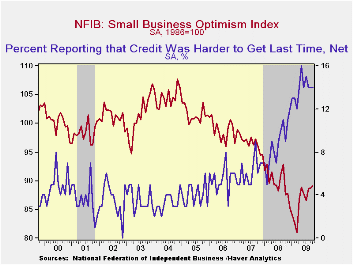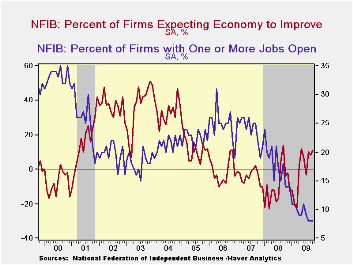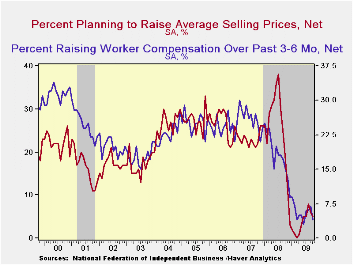 Global| Nov 10 2009
Global| Nov 10 2009U.S. Small Business Optimism Improves But Credit Remains Tight With Hiring Cautious
by:Tom Moeller
|in:Economy in Brief
Summary
Small business' optimism recently recovered from its recession low, but the latest readings indicate further, modest upside movement. The National Federation of Independent Business (NFIB) indicated that their small business optimism [...]
 Small
business' optimism recently recovered from its recession low, but the
latest readings indicate further, modest upside movement. The National
Federation of Independent Business (NFIB) indicated that their small
business optimism index rose to 89.1 during October, the third
consecutive monthly gain. The latest level was the highest since
September '08. During the last ten years, there has been an
85% correlation between the level of the NFIB index and the two-quarter
change in real GDP.
Small
business' optimism recently recovered from its recession low, but the
latest readings indicate further, modest upside movement. The National
Federation of Independent Business (NFIB) indicated that their small
business optimism index rose to 89.1 during October, the third
consecutive monthly gain. The latest level was the highest since
September '08. During the last ten years, there has been an
85% correlation between the level of the NFIB index and the two-quarter
change in real GDP.
 The percentage of small businesses expecting the
economy to improve bounced back after earlier weakness to 11, the
highest since May. The percentage which thought that now was a good
time to expand the business slipped m/m to a still-improved 7, near the
highest level this year. Moreover, the percent reporting higher
net-earnings this quarter versus last year held at -40 m/m for the
third month, meaning fewer were reporting negative earnings versus last
year. It was the highest level since November.
The percentage of small businesses expecting the
economy to improve bounced back after earlier weakness to 11, the
highest since May. The percentage which thought that now was a good
time to expand the business slipped m/m to a still-improved 7, near the
highest level this year. Moreover, the percent reporting higher
net-earnings this quarter versus last year held at -40 m/m for the
third month, meaning fewer were reporting negative earnings versus last
year. It was the highest level since November.
Tight credit conditions continued as 14% of firms indicated that it was harder to get credit. That was near the 1981 high of 15%. Perhaps because of these tight conditions, the recent improvement in business' sentiment has done little, if anything, to improve hiring intentions. The percentage of firms planning to raise employment remained in the net-layoff region and the percentage of firms with one or more job openings held at just 8% during October, the lowest level since 1982. During the last ten years there has been a 74% correlation between the NFIB employment percentage and the six-month change in nonfarm payrolls. Also to the downside, the percentage expecting credit conditions to ease slipped back to the February low.
 Pricing conditions eased. The percentage of
firms actually raising prices improved to -17
(indicating deflation) and remained just above the record low. During
the last ten years there has been a 69% correlation between the
six-month change in the producer price index and the level of the NFIB
price index. The percentage of firms planning
to raise prices gave back the prior two months' improvement and fell to
a net 6, though that remained up from the March low of zero. Worker
compensation fell back to near its recent series' low.· The largest,
single most important problems seen by business were poor sales (33%),
taxes (22%, near the highest level since 2007), government requirements
(11%), insurance cost & availability (8%), competition from
large businesses (6%) and inflation (2%).
Pricing conditions eased. The percentage of
firms actually raising prices improved to -17
(indicating deflation) and remained just above the record low. During
the last ten years there has been a 69% correlation between the
six-month change in the producer price index and the level of the NFIB
price index. The percentage of firms planning
to raise prices gave back the prior two months' improvement and fell to
a net 6, though that remained up from the March low of zero. Worker
compensation fell back to near its recent series' low.· The largest,
single most important problems seen by business were poor sales (33%),
taxes (22%, near the highest level since 2007), government requirements
(11%), insurance cost & availability (8%), competition from
large businesses (6%) and inflation (2%).
About 24 million small businesses exist in the United States. Small business creates 80% of all new jobs in America and the NFIB figures can be found in Haver's SURVEYS database.
Financial Regulation: Past and Future is the title of yesterday's speech by Fed Governor Daniel K. Tarullo and it can be found here here.
| Nat'l Federation of Independent Business | October | September | Y/Y | 2008 | 2007 | 2006 |
|---|---|---|---|---|---|---|
| Small Business Optimism Index (SA, 1986=100) | 89.1 | 88.8 | 1.8% | 89.8 | 96.7 | 98.9 |
| Percent of Firms Expecting Economic Improvement | 11 | 8 | -4 | -10 | -4 | -1 |
| Percent of Firms With One or More Job Openings | 8 | 8 | 14 | 18 | 24 | 25 |
| Percent of Firms Raising Avg. Selling Pric1es (Net) | -17 | -21 | 15 | 17 | 15 | 20 |
Tom Moeller
AuthorMore in Author Profile »Prior to joining Haver Analytics in 2000, Mr. Moeller worked as the Economist at Chancellor Capital Management from 1985 to 1999. There, he developed comprehensive economic forecasts and interpreted economic data for equity and fixed income portfolio managers. Also at Chancellor, Mr. Moeller worked as an equity analyst and was responsible for researching and rating companies in the economically sensitive automobile and housing industries for investment in Chancellor’s equity portfolio. Prior to joining Chancellor, Mr. Moeller was an Economist at Citibank from 1979 to 1984. He also analyzed pricing behavior in the metals industry for the Council on Wage and Price Stability in Washington, D.C. In 1999, Mr. Moeller received the award for most accurate forecast from the Forecasters' Club of New York. From 1990 to 1992 he was President of the New York Association for Business Economists. Mr. Moeller earned an M.B.A. in Finance from Fordham University, where he graduated in 1987. He holds a Bachelor of Arts in Economics from George Washington University.






